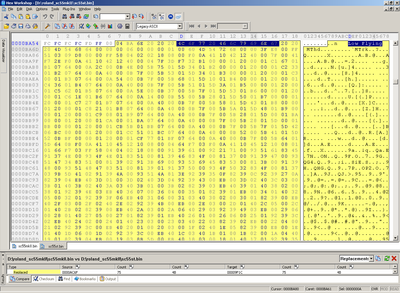Spikey wrote on 2023-12-05, 07:46:
but if the WaveROM data is different, then couldn't the encoding and processing be different?
you can think of it as ZIP archive, as far as it's ZIP compressed, always the uncompression/unpacking is done in the same way, even if the sounds (data) inside are not the same.
Spikey wrote on 2023-12-05, 07:46:
I guess I'm confused how a SC-8820 is representative of a SC-55 in terms of ROM or anything else.
it's representative of how the WaveROMs are packed/compressed, as the old thread I pointed out:
Re: About Roland Virtual Sound Canvas 3
shows all WaveROMs we inspected: SC-55 (and variants), SC-88 (and variants) and SC-8820 use the same packing format to store the data in the WaveROM. also, you can extract and compare sounds between those ROMs - if something doesn't look right between such comparisons you can account for potential differences. so, you can do it in fact-based way, not in guess-based way, as it was my initial point.
please, also note that SC-8820 has separate SC-88 WaveROM inside it! in fact if you look at SC-8820 Service Manual PDF, you will see it has insane amount of ROMs inside it (IC5, IC6, IC7, IC8, IC39) - those I guess are just ROMs from different older devices, between which SC-8820 is capable to switch as its current working mode, that in fact explains why:
Re: About Roland Virtual Sound Canvas 3
I also found several such ROMs in the SCVA DLLs, for example the aforementioned separate SC-88 ROM. I won't be surprised, if SC-8820 has even SC-55 ROM, it's just no one found its location - either in the DLLs or on its mainboard, because I doubt anyone knows, what those ROMs in IC5, IC6, IC7, IC8 and IC39 on the SC-8820 mainboard represent - at least I don't know, what I know is for sure one of those chips is the SC-88 ROM I found in the SCVA DLLs.
Spikey wrote on 2023-12-05, 07:46:
The one I'm curious about is the CM-300, which uses a PCM61, but that's another story.
I think in general Burr-Brown, i.e. PCM61 are much more reputable DAC maker than NEC (6379 and 63200), but that doesn't mean PCM61 sounds better, I don't know, which sounds better and personally I don't even care, because as I mentioned to me, IMHO, the biggest advantage of CM-300 is those "RLP-3037" (early CM-300 units, circa 1991 ) and "RLP-3170"(later CM-300 units, circa 1992) boards inside it, because they are self-contained Synth modules with MIDI In/Out and I2S Digital Audio Out, i.e. you can hook them easily to logic analyzer as discussed earlier here and make digital captures - then that capture you can play on any DAC you like. So, really "RLP-3037" and "RLP-3170" inside CM-300 have no substitution in such functionality. other modular board like for example SCB-55 has no digital, but analog output , plus it's not even SC-55, but SC-55mkII based.
